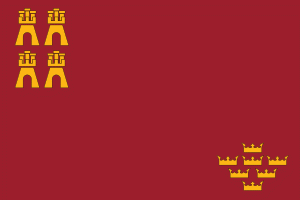Region of Murcia (Región de Murcia)
 |
 |
A jurisdiction of the Crown of Castile since the middle ages, the Kingdom of Murcia was replaced in the 19th century by territory primarily belonging to the provinces of Albacete and Murcia (and subsidiarily to those of Jaén and Alicante). The former two were henceforth attached to a 'historical region' also named after Murcia. The province of Murcia constituted as the full-fledged single-province autonomous community of the Region of Murcia in 1982.
The region is bordered by Andalusia (the provinces of Almería and Granada), Castile La Mancha (the province of Albacete), the Valencian Community (province of Alicante), and the Mediterranean Sea. The autonomous community is a single province. The city of Murcia is the capital of the region and the seat of the regional government, but the legislature, known as the Regional Assembly of Murcia, is located in Cartagena. The region is subdivided into municipalities.
The region is among Europe's largest producers of fruits, vegetables, and flowers, with important vineyards in the municipalities of Jumilla, Bullas, and Yecla that produce wines of Denominación de origen. It also has an important tourism sector concentrated on its Mediterranean coastline, which features the Mar Menor saltwater lagoon. Industries include the petrochemical and energy sector (centered in Cartagena) and food production. Because of Murcia's warm climate, the region's long growing season is suitable for agriculture; however, rainfall is low. As a result, in addition to the water needed for crops, there are increasing pressures related to the booming tourist industry. Water is supplied by the Segura River and, since the 1970s, by the Tagus-Segura Water Transfer, a major civil-engineering project that brings water from the Tagus River into the Segura under environmental and sustainability restraints.
Notable features of the region's extensive cultural heritage include 72 cave art ensembles, which are part of the rock art of the Iberian Mediterranean Basin, a World Heritage Site. Other culturally significant features include the Council of Wise Men of the plain of Murcia and the tamboradas (drumming processions) of Moratalla and Mula, which were declared intangible cultural heritage by UNESCO. The region is also the home of Caravaca de la Cruz, a holy city in the Catholic Church that celebrates the Perpetual Jubilee every seven years in the Santuario de la Vera Cruz.
The toponym (place name) Murcia is of uncertain origin. According to Francisco Cascales, it could refer to the Roman goddess Venus Murcia, from the myrtles on the banks of the Segura River. Historical studies conclude that, like the deity, Murcia is of Latin origin deriving most likely from Myrtea or Murtea ('place of myrtles' or 'place where myrtles grow'). Furthermore, Mursiya (already documented in the Islamic period as the name of the city of Murcia), was the adaptation in the Arabic of the pre-existing Latin. According to Bienvenido Mascaray, it is also possible that the name originates from the Iberian language in the form m-ur-zia, meaning 'the water that empowers or moistens.'
The use of "Murcia" to define the present region has its origin in the Taifa of Murcia, an Arab kingdom that existed at different times in the 11th, 12th, and 13th centuries. After the Christian conquest of Murcia between 1243 and 1266, the Kingdom of Murcia emerged, a territorial jurisdiction that formed its own institutions until its demise in 1833.
After the provincial administrative reform of 1833, the first Region of Murcia was formed from the provinces of Albacete and Murcia. In the first attempt at decentralization, during the First Republic, this region was one of the 17 member states that was contemplated by the Spanish Draft Constitution of 1873, proclaiming during that year the so-called Cantón Murciano, as an attempt to form a regional canton in the context of the Cantonal rebellion.
In 1978, the Regional Council of Murcia was created as a pre-autonomous body, in effect until 1982, when the Statute of Autonomy of the Region of Murcia was approved. The province of Murcia was then granted autonomy under the official name of the Autonomous Community of the Region of Murcia in the framework of the political process in place during the Spanish transition to democracy.
Map - Region of Murcia (Región de Murcia)
Map
Country - Spain
 |
 |
| Flag of Spain | |
Anatomically modern humans first arrived in the Iberian Peninsula around 42,000 years ago. The ancient Iberian and Celtic tribes, along with other pre-Roman peoples, dwelled the territory maintaining contacts with foreign Mediterranean cultures. The Roman conquest and colonization of the peninsula (Hispania) ensued, bringing the Romanization of the population. Receding of Western Roman imperial authority ushered in the migration of different non-Roman peoples from Central and Northern Europe with the Visigoths as the dominant power in the peninsula by the fifth century. In the early eighth century, most of the peninsula was conquered by the Umayyad Caliphate, and during early Islamic rule, Al-Andalus became a dominant peninsular power centered in Córdoba. Several Christian kingdoms emerged in Northern Iberia, chief among them León, Castile, Aragon, Portugal, and Navarre made an intermittent southward military expansion, known as Reconquista, repelling the Islamic rule in Iberia, which culminated with the Christian seizure of the Emirate of Granada in 1492. Jews and Muslims were forced to choose between conversion to Catholicism or expulsion, and eventually the converts were expelled through different royal decrees.
Currency / Language
| ISO | Currency | Symbol | Significant figures |
|---|---|---|---|
| EUR | Euro | € | 2 |
| ISO | Language |
|---|---|
| EU | Basque language |
| CA | Catalan language |
| GL | Galician language |
| OC | Occitan language |
| ES | Spanish language |
















